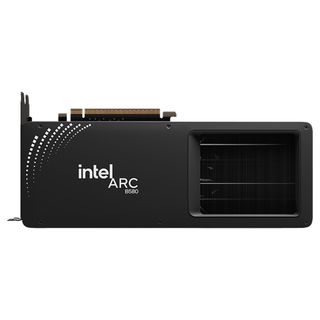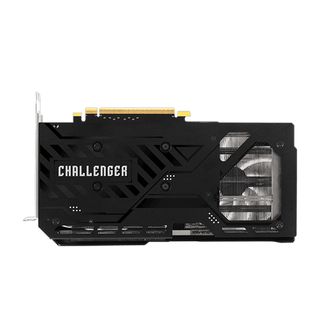Mainstream PC gamers rejoice because Team Blue’s hit back hard and fast with its Battlemage GPU generation, building off of the success (and failures) of its Alchemist line from nearly three years ago. There are two members of the Battlemage family right now, the Arc B580 and B570 , but which is the better of the two?
There’s a lot to go over when it comes to the Intel Arc B580 vs B570 graphics cards, and to find out which is best for you, I’m going to analyze them based on their price, specs, and performance so you can see which is right for you.
Intel Arc B580 vs B570: Price (Image credit: Future) Starting with their respective sticker prices, the Intel Arc B570 is the cheaper of the two available since January 16, 2025, for $219 / £219 / AU$350 from Team Blue’s partners.
By comparison, the Intel Arc B580 was released earlier, on December 13, 2024, with a slightly higher price tag of $249.99 / £249.99 / AU$449. Unlike the cheaper variant, there was a Limited Edition (Intel-made) GPU available, though it’s hard to come by now, and it’s particularly fetching as budget graphics cards go.
Taking the respective MSRPS into consideration, the B570 is cheaper than the B580 by a full $31 / £31 / AU$99 (or roughly 13%). However, that’s only one side of the story. Because there was no Intel-made B570, there was also no strict adherence to the sticker price, with some of the AIB models rivaling the MSRP of the pricier B580 by default.
Similarly, if you were not able to get your hands on a Limited Edition B580 at release, then you may be paying upwards of $300 / £300 / $AU500 (or beyond) from partners like Acer , ASRock, Gunnir, and Sparkle.
Winner: Intel Arc B570 (at MSRP)Intel Arc B580 vs B570: Specs (Image credit: Future) Swipe to scroll horizontally
Header Cell – Column 0 Intel Arc B580
Intel Arc B570
% Difference
Process Technology
TSMC N5
TSMC N5
N/A
Transistors (Billion)
19.6
19.6
0
Compute units
20
18
11.1
Shaders
2,560
2,304
11.1
AI/Matrix cores
160
144
11.1
Ray Tracing Cores
20
18
11.1
Render Output Units
80
80
0
Texture Mapping Units
160
144
11.1
Boost Clock (MHz)
2,670
2,500
6.8
Memory type
GDDR6
GDDR6
N/A
VRAM (GB)
12
10
20
VRAM Bus Width
192-bit
160-bit
20
VRAM Speed (Gbps)
19
19
0
Bandwidth (GB/s)
456
380
20
TDP (watts)
190
150
26.6
PCIe Interface
PCIe 4.0 x8
PCIe 4.0 x8
N/A
MSRP
$249.99 / £249.99 / AU$449
$219 / £219 / AU$350
14.1
Starting with the similarities first, both the Intel Arc B570 and B580 feature GDDR6 memory, are built on TSMC’s 5nm process, feature an identical amount of transistors, and the same amount of ROPs. That’s where things differ, however, as the two cards are notably different when digging below the surface.
Chiefly, the Intel Arc B570 features 10GB VRAM, but the B580 bumps that up to 12GB (a 20% increase). We also see this increase with the memory bus width, allowing for substantially more bandwidth at 456GB/s for the B580 compared to 380GB/s for the B570. Other improvements in the B580’s favor are more granular, such as a slight bump in Compute Units, Shaders, AI cores, and RT cores for the B580.
On paper, it’s no contest between the B570 and B580, as the latter graphics card offers more power under the hood. However, this comes at the cost of an increased power draw, with the former featuring a 150W TGP compared to the latter’s 190W TGP, which is also an increase of 20%. A modest PSU should be able to handle both (a 500W power supply should be plenty), but it’s something to be aware of when weighing up the two for your rig.
Intel Arc B580 vs B570: Performance (Image credit: Future) Now that we’ve outlined the price and specs of the two cards, it’s time to put the B580 vs B570 to the test in terms of performance.
Starting with the synthetics, the Arc B580 achieved scores of 153,083 and 35,780 in 3DMark Night Raid and Fire Strike, respectively. In contrast, the B570 scored 136,851 and 30,468 (a difference in favor of the former by 11.8% and 17.4%).
There’s a similar lead with PassMark 3D Graphics (Total) and GeekBench 6 Compute (OpenGL), with the B580 scoring 19,519 and 98,550 compared to the B570’s 16,680 and 86,426 (differences of 17% and 14% apiece).
Neither the B580 nor B570 thrives in 1440p, but it’s worth noting their respective QHD performance. This can be seen with Black Myth: Wukong (Cinematic, 50% Upscaling) at 31fps from the former but only 26fps from the latter; neither is ideal.
The leading Battlemage model achieves 61fps in Cyberpunk 2077 (Ultra) natively, but the secondary GPU can’t quite match it at 53fps, falling just short. Returnal (Epic) is no sweat for the B580, with a 71fps average, whereas the B570 achieved an average of 61fps. That means a performance difference of around 19%.
1080p performance is more of a sweet point for these two Battlemage GPUs. It’s not too big a jump in Black Myth: Wukong (34fps) from the B580 but just under playable from the B570 (29fps). Cyberpunk 2077 is bumped up to 91fps in 1080p on the B580 and 82fps on the B570 (a difference of 10.9%).
Returnal also saw a substantial improvement in Full HD, with the B580 achieving 90fps and the B570 managing just 55fps by comparison (a difference of 64.6%). The B580 is the more powerful of the two synthetically and for gaming in both 1440p and 1080p.
Lastly, we can look at the creative performance of the Battlemage graphics cards. In PugetBench for Adobe Premiere, the B580 scored 10,009 compared to the B570’s 9,309 (a 7.5% difference).
Things are more dramatic, however, with Handbrake 1.6’s 4K to 1080p H.264 encoding, with the B580 rendering at 226fps and the B570 rendering at 155fps (a 45.8% difference). While far from leading, the B580 racked up 908 in Blender 4.30’s Monster benchmark, compared to the B570’s 687 figure (a jump of 32.1%).
As such, we can conclusively say that the B580 is better for creative use, at least as far as a budget GPU is concerned.
Intel Arc B580 vs B570: Verdict (Image credit: Future / John Loeffler) Based on everything we’ve uncovered about the Intel Arc B580 vs B570, we’re confident in recommending the pricier of the two as its performance capabilities are far superior to the cheaper model in terms of synthetics, performance, and creative workloads, while only being $31 / £31 / AU$99 more expensive at MSRP. Even outside of the sticker price, the otherwise aggressive pricing of the B570 is washed as Intel’s partners set the price.
The Intel Arc B580 is a fantastic graphics card for 1080p and 1440p gaming under the right conditions, but you’re going to get the highest framerates when utilizing XeSS (the company’s version of upscaling).
While our tests were done with native figures, you could bump things up considerably by downscaling to 1080p and then outputting at 1440p instead of displaying natively through the addition of AI-powered cores so either will give you fantastic gaming performance on a tight budget.
You might also like… 









